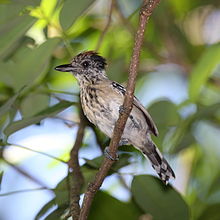Black-crested antshrike
| Black-crested Antshrike | |
|---|---|

| |
| male | |
| Scientific classification | |
| Kingdom: | |
| Phylum: | |
| Class: | |
| Order: | |
| Family: | |
| Genus: | |
| Species: | S. canadensis
|
| Binomial name | |
| Sakesphorus canadensis Linnaeus, 1766
| |
The Black-crested Antshrike (Sakesphorus canadensis) is a passerine bird in the antbird family. It is a resident breeder in tropical South America in Trinidad, Colombia, Venezuela, the Guianas, northern Brazil and northeastern Peru.
This is a bird of undergrowth in mangrove or other swampy forest and thickets near water. It is usually found as territorial pairs. The female lays two purple-lined white eggs in a deep cup nest suspended below a branch or vine. They are incubated by both sexes for 14 days to hatching, the female always brooding at night. The chicks fledge in another 12 days.

The Black-crested Antshrike is typically 15.7 cm long, and weighs 24 g. The adult male has a black head, prominent crest, throat and breast, a rufous-brown back, black wings with white feather edges, a short black tail and a white belly.
The female and immature males have a chestnut crest and head with black and white barring on the cheeks, dull brown upperparts, black-streaked buff underparts, and browner wing and tail feathers than the male.
The Black-crested Antshrike feeds on insects and other arthropods gleaned from foliage. It will also take small lizards and berries. It is an inconspicuous species, often first located by its song, an accelerating and ascending series of musical notes cuew-cuew-cuew-cue-cue-cue-cu-cu-cu-cu, or the call, a snarled churrrr.
References
- ffrench, Richard (1991). A Guide to the Birds of Trinidad and Tobago (2nd edition ed.). Comstock Publishing. ISBN 0-8014-9792-2.
{{cite book}}:|edition=has extra text (help) - Hilty, Steven L (2003). Birds of Venezuela. London: Christopher Helm. ISBN 0-7136-6418-5.

